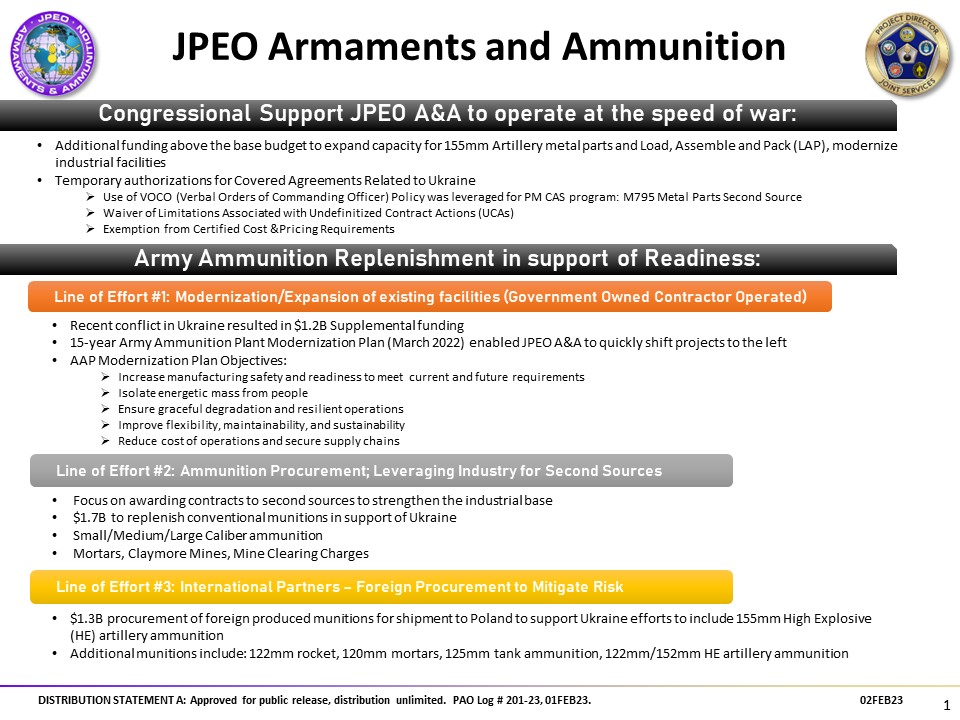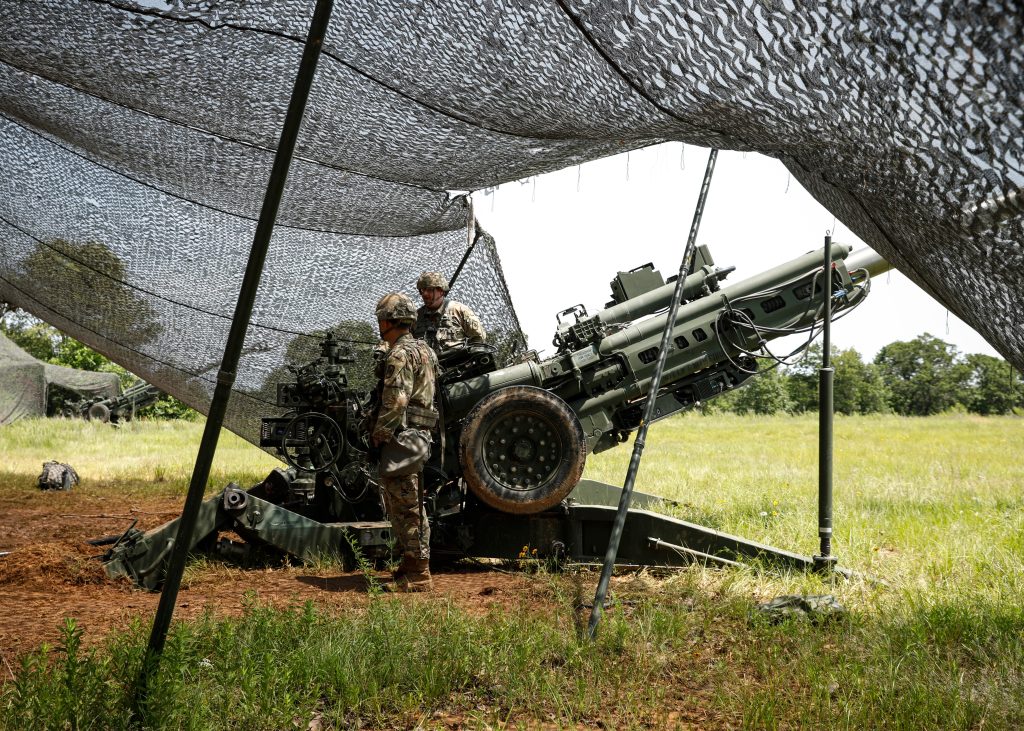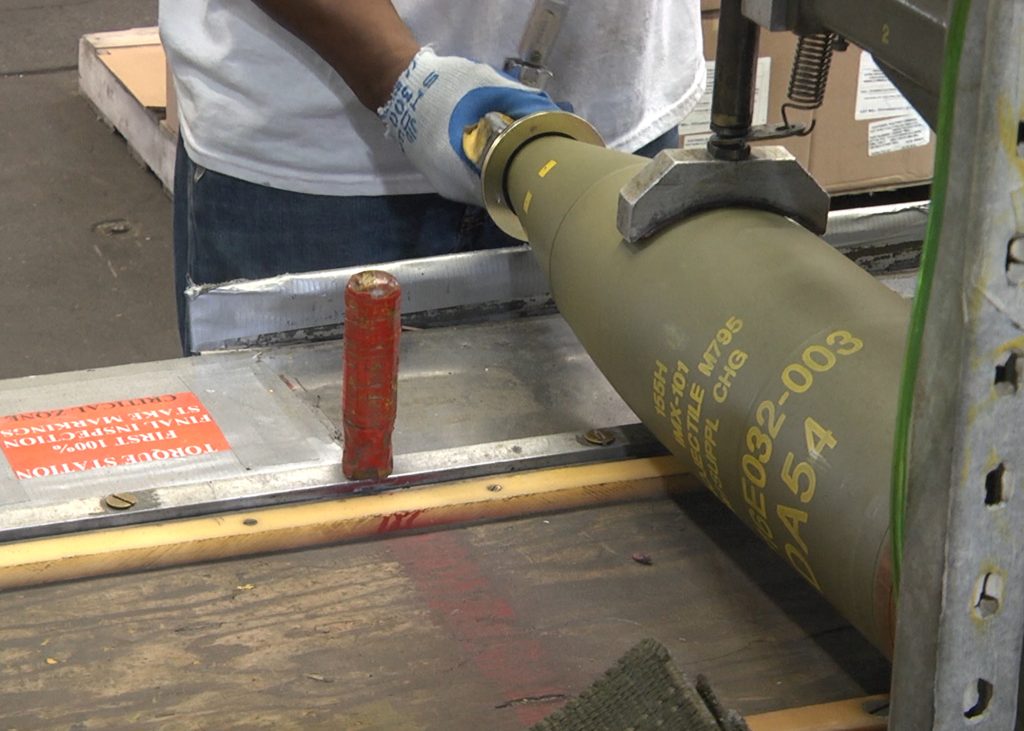
PREPARED FOR PALLETS: An ammunition handler at Blue Grass Army Depot in Lexington, Kentucky, prepares a number of 155 mm projectile rounds to be repalletized, Sept. 8, 2022. The U.S. Army is updating it’s GOCO ammunition production facilities to keep pace with increased demand. (Photo by Dori Whipple, Joint Munitions Command)
Ramped up efforts to support Ukraine are driving U.S. Army modernization of manufacturing technologies and projectiles.
by Cheryl Marino
U.S. Army leaders have long acknowledged the need to upgrade the nation’s WWII-era government-owned, contractor-operated (GOCO) ammunition production facilities. Ukraine’s needs in the face of invasion by Russia have just jump-started the modernization process.
As a result of the rapid escalation of U.S. efforts to support Ukraine, the Joint Program Executive Office for Armaments and Ammunition (JPEO A&A) will need to modernize its 155 mm ammunition GOCO facilities to meet the increased demands of the U.S. Army and to continue its support mission to Ukraine. This push to produce more sophisticated artillery systems not only assists Ukraine, it also drives the U.S. Army industrial base to boost its own manufacturing capabilities.
GOCO facilities, used for manufacturing operations, are at the crux of the nation’s organic industrial base. Their modernization will be essential for “rebuilding the arsenal of democracy,” according to Brig. Gen. John T. Reim, joint program executive officer for A&A and commanding general of Picatinny Arsenal in New Jersey. These facilities enabled the war effort during World War II and today play a vital role in the nation’s defense. U.S. Army aid to Ukraine is an opportunity to use stockpiles of old inventory and provide for the addition of new artillery shells, which is an Army chief of staff priority.
“These modernization efforts are related to Ukraine and will yield benefits to the U.S. Army and other military services for many years into the future,” said Greg O’Connor, production base manager for Project Director Joint Services (PD JS), within JPEO A&A. “GOCO modernization efforts are required, regardless of the Ukraine war. Aging infrastructure and facilities require modernization and maintenance to continue to meet production requirements for the U.S. joint force.”
The modernization work that is directly related to Ukraine is the 155 mm ammunition production expansion, which supports the M777 howitzers sent to theater and howitzers donated by allied nations. PD JS maintains the U.S. 155 mm ammunition GOCO production facilities where the ammunition supporting Ukraine is produced, and the office has been instrumental in using lessons learned to modernize these facilities to meet the increased demands of the U.S. Army.
“The emerging need for 155 mm ammunition has driven efforts not just to modernize related manufacturing facilities, but to dramatically expand 155 mm production capacity. To meet these near-term increased capacity requirements, while improving the long-term sustainability of the manufacturing capabilities, existing equipment and facilities are being modernized and new production lines are being constructed using cutting-edge manufacturing technologies,” O’Connor said.
Additional funding above the base budget, recently approved by Congress will enable JPEO A&A to operate at the “speed of war” to expand capacity for 155 mm artillery metal parts, the loading, assembly and packing and the modernization of industrial facilities. In January, Congress approved $1.7 billion for ammunition procurement, leveraging industry for second sources to replenish conventional munitions in support of Ukraine, and $1.3 billion to procure foreign-produced munitions, including the 155 mm high-explosive artillery ammunition to support Ukraine efforts. By leveraging international suppliers, every round pulled from an international partner is one less coming out of U.S. stocks.

OPERATING AT THE SPEED OF WAR: This strategic plan outlines Congressional support for the JPEO A&A mission. Army ammunition replenishment in support of readiness includes modernization and expansion of existing GOCO facilities, ammunition procurement; leveraging industry for second sources and international partners – foreign procurement to mitigate risk. (Graphic by JPEO A&A)
GOCO AT THE READY
GOCOs, which are responsible for the production of ammunition and ammunition components—including energetic materials like explosives and propellants—represent the organic, or government-owned, capabilities for ammunition production that are complemented by numerous commercial production facilities, referred to as contractor-owned, contractor-operated.
The majority of ammunition used by the military services is produced across five Army ammunition plants operated by commercial companies and managed as acquisition programs by Project Manager Combat Ammunition Systems (PM CAS), also within JPEO A&A. PM CAS is the life cycle manager responsible for the development, production and fielding of indirect-fire munitions, mortar and fire-control systems. These GOCO ammunition production facilities are ready and fully capable of producing ammunition at the rates necessary to meet requirements set by DOD.
Project Director Joint Services has modernization responsibilities at seven GOCO ammunition production facilities within the organic industrial base: Holston Army Ammunition Plant (HSAAP) in Kingsport, Tennessee; Iowa Army Ammunition Plant (IAAAP) in Middletown, Iowa; Lake City Army Ammunition Plant (LCAAP) in Independence, Missouri; Milan Army Ammunition Plant (MLAAP) in Milan, Tennessee; Quad City Cartridge Case Facility (QCCCF) at Rock Island Arsenal, Illinois; Radford Army Ammunition Plant (RFAAP) in Radford, Virginia; and Scranton Army Ammunition Plant (SCAAP) in Scranton, Pennsylvania.
The ongoing work at four of the GOCOs directly supports the Ukrainian war efforts, O’Connor said. Holston Army Ammunition Plant is producing explosives used to fill artillery shells; Radford is producing propellant for various ammunition systems; Scranton is producing metal parts for artillery shells, and Iowa Army Ammunition Plant is performing the loading, assembly and packing of large ammunition systems. Those activities include filling the ammunition projectiles with explosives, assembling propulsion systems and other components like fuzes and fins, and then packaging the complete ammunition systems so they are safe to transport and store.
PD JS’s most significant efforts in supporting the U.S. efforts to assist Ukraine are the production capacity expansion activities that will take place at Scranton, Iowa and Holston Army Ammunition Plans to support 155 mm artillery ammunition production requirements.
At Scranton Army Ammunition Plant, the Army is making an “unprecedented investment” into increased capacity and capability to produce 155 mm artillery projectile metal parts. Currently, the facility in Scranton consists of a single operational production line, producing only M795 projectiles—the U.S. Army and Marine Corps standard 155 mm high-explosive (HE) projectile. In the future, however, four to five modern production lines will be collectively capable of producing the current M795 projectile at much higher rates. Additionally, Scranton will also be capable of producing the new longer-range M1128, XM1113 and XM1210 projectiles for 155 mm howitzers. “Flexibility and automation are being emphasized to ensure ability to meet current requirements as well as those that emerge in the future,” O’Connor said.
Other investments at Scranton to increase capacity for artillery metal parts, include the procurement of new press systems, metal cutting and forming equipment, new and upgraded furnaces, foundation repairs, fire suppression and electrical system upgrades, process line robots, coating systems and material handling systems, as well as removal or relocation of legacy equipment.
“The Army is making significant investments at GOCO facilities to increase production capacity and reduce equipment obsolescence,” O’Connor said. “The new machinery, which includes automation and improved control systems, will not only improve product quality, but also reduce risk to employees and increase throughput.”
|
ASSURED MUNITIONS The COVID pandemic and current world events have made it clear that a secure and resilient supply chain with sufficient capacity is essential to being able to respond to a surge in production demand under difficult circumstances. The JPEO A&A Directorate of Integration leads the charge for managing supply chain risk under the aegis of an effort called Assured Munitions. Depending on the complexity of the item, dozens to hundreds of components and precursor materials are required to produce munitions. These items are sourced from a global supply chain. Working in concert with all of the program offices within JPEO A&A, the Directorate of Integration is mapping the supply chains for the items in the JPEO A&A portfolio. Assessments of risk have been made and particular materials have been identified for mitigation. The Defense Production Act Title III is a key tool for reshoring critical materials production when they are not available within the continental United States. In concert with the Critical Energetics Working Group—led by the Office of the Assistant Secretary of Defense for Industrial Base Policy—and our service partners, JPEO A&A has identified critical materials for reshoring. Subsequently, agreements with U.S. industry partners have been and are being pursued to establish production capacity in the U.S. where it does not presently exist. —JPEO A&A |
WHAT PROMPTED THIS
Since April 2022, the U.S. government has provided Ukraine with artillery—like the M777 lightweight 155 mm towed howitzer—specialized ammunition and training through PM CAS and a joint service program between the U.S. Army and U.S. Marine Corps which is managed by Program Manager Towed Artillery Systems (PM TAS), with BAE Systems as the prime contractor.
In addition to PD JS, two other program offices within JPEO A&A provide life cycle support to the U.S. 155 mm artillery mission. PM TAS manages the production, fielding and support of the M777 howitzer, while Project Manager Combat Ammunition Systems (PM CAS) has the responsibility for managing the production of the 155 mm ammunition.
PM TAS was one of the first U.S. government organizations required to provide a weapon system capability to the Ukrainian armed forces. As a result, according to Christopher Ayoub, acting deputy program manager at PM TAS, the M777 howitzer has been at the forefront of every major milestone, from initial training, fielding and remote maintenance, to its transition to sustainment.
Because the M777 was the first to go, PM TAS has been able to provide senior leaders with recommended direction as the Russia-Ukraine war transitions from the initial equipping phase to the enduring sustainment and logistics support that will shape the war going forward.
In January, DOD announced a significant new package of security assistance for Ukraine, including the authorization of a presidential drawdown of security assistance valued at up to $425 million, as well as $1.75 billion in Ukraine security assistance initiative funds. U.S. commitment includes critical air-defense capabilities, as well as armored infantry vehicles and more equipment that Ukraine is using effectively, like Javelin anti-tank missiles, conventional and long-range rockets for the U.S.-provided M142 High Mobility Artillery Rocket System, 155 mm artillery ammunition and training.
The PM TAS office carries out the executive orders as stated in various presidential drawdowns for 105 mm and 155 mm towed artillery support of the M119 and M777 howitzers, respectively.
The team has been responsible for providing a full towed artillery capability to the Ukrainian armed forces, including specific configuration technical manuals, training, spares, engineering support and full maintenance support via 24-hour remote maintenance. “PM TAS has been critical to the strategic development and execution of activities that provide a superior level of support to the Ukrainian warfighter,” Ayoub said. “Our team supporting the remote maintenance meetings and chats have ingrained themselves with our Ukrainian partners by providing trusted subject matter expertise that can be replicated for U.S. forces.”
PM TAS is providing lessons learned from the various program milestones to allow the Project Manager Self-Propelled Howitzer Systems (PM SPHS) team to seamlessly provide a full capability to the Ukrainian armed forces for immediate battlefield effects. The PM TAS team is also providing tactical guidance to various senior leaders who are developing the sustainment strategy for all weapon systems.

HELLO HOWITZER: Soldiers from the Arkansas National Guard’s 206th Field Artillery Regiment conduct training with the M777 howitzer on Fort Chaffee in western Arkansas, June 11, 2022. The U.S. government has supplied artillery—including the M777 lightweight 155 mm towed howitzer—to the armed forces of Ukraine since 2022. (Photo by Pfc. Savannah Smith, 119th Mobile Public Affairs Detachment)
THE NEED FOR SPEED
After Ukraine’s initial request for M777 howitzer components, the need for specialized ammunition followed closely behind.
This time, PM CAS stepped up to the challenge, providing 155 mm high-explosive artillery munitions like projectiles, propellant, fuzes and the Excalibur projectile—a GPS-guided projectile with impeccable accuracy at extended ranges—in support of Ukraine and U.S. Army demands.
“We knew we couldn’t just send ammunition to Ukraine without also providing ammunition training,” said Keith Gooding, JPEO A&A director of talent management and Senior Service College Fellowship. “With this support to Ukraine, Picatinny has felt the increased importance on the U.S. 155 mm ammunition supply chain in order to meet requests and to continue to support U.S. requirements.”
Project Manager Combat Ammunition Systems taps into the complex supply chain across the industrial base, including organic and commercial suppliers for 155 mm ammunition. After production is complete, rounds of ammunition are shipped to government depots in the U.S. and around the world where Joint Munitions Command can issue and distribute as needed.
The program office develops, produces and equips U.S. Soldiers and Marines with conventional artillery and mortar ammunition, precision ammunition, mortar weapons, and mortar fire control systems. Under the Single Manager for Conventional Ammunition (SMCA) responsibilities, PM CAS also procures ammunition for the U.S. Marine Corps, U.S. Air Force, U.S. Special Operations Command and our allies.
“PM CAS is the life cycle program manager of artillery and mortar products in the categories of precision-guided munitions [including Excalibur and the Precision Guidance Kit], conventional munitions for mortars and artillery, artillery propellant and primers, fuzes and fuze setters, mortar weapon systems and mortar fire control systems,” said Peter Burke, deputy program manager for CAS.
“Through its support to Ukraine, the U.S. has looked deeply into the current state of the industrial base that needs to operate at a scale not seen since the 1980s,” Burke said. “The result was the decision to accelerate and expand the supply chain to meet unprecedented wartime demand, greatly strengthening the industrial base.”
“We deliver lethal conventional and leap-ahead munitions and weapons to the warfighter, giving them a materiel edge over adversaries,” said Col. Leon Rogers, who is responsible for the PM CAS portfolio.
According to Ayoub, the M777 howitzer is significantly “more modern and accurate than the 152 mm towed artillery fleet that both Russia and Ukraine employ, and has a precision guidance munition capability out to significant ranges, providing overmatch capabilities on the battlefield,” which has given Ukrainian soldiers a vital boost in firepower on the battlefield.
Shortages of Soviet-standard 152 mm ammunition—supplied by Russia and China—have reduced the value of Soviet-era artillery and have driven Ukraine to request support from the U.S. and its allies. The request has given the U.S. the opportunity to reengage with the ammunition industrial base, modernizing processes and facilities and increasing capacities where needed.

PROJECTILE PRODUCTION: A worker inspects a 155 mm projectile at Iowa Army Ammunition Plant on May 11, 2022. Iowa Army Ammunition Plant produces and delivers component assembly and medium- and large-caliber ammunition items for the DOD, using modern production methods in support of worldwide operations. (Photo by Dori Whipple, Joint Munitions Command)
CONCLUSION
Modernization of the nation’s GOCO armaments production facilities was already an ongoing effort, and it is now even more critical for continued support to Ukraine and replenishing U.S. stockpiles.
“The recent events in Ukraine have clearly demonstrated the strategic importance of the U.S. Army organic industrial base. Strong Congressional support for additional funding, combined with new acquisition authorities, creates a once-in-a-generation opportunity to invest in the future of ammunition production,” said PD JS project director Col. Jason Bohannon.
Going forward, he said, cutting-edge manufacturing technologies will be leveraged to create a more reliable and sustainable source of ammunition, and to create efficiencies that lead to lower operating costs for years to come. “The modernized GOCOs will provide the critical manufacturing capability necessary to ensure the Joint Force and our international partners have the ammunition required to deploy, fight and win our nation’s wars.”
For more information go to https://jpeoaa.army.mil/.
CHERYL MARINO provides contract support to the U.S. Army Acquisition Support Center at Fort Belvoir, Virginia, as a writer and editor for Network Runners Inc. and Army AL&T magazine. She holds a B.A. in Communications from Seton Hall University and has more than 20 years of writing and editing experience in both the government and private sectors. In addition to corporate communications, she is a feature writer and photojournalist for a biannual New Jersey travel magazine.







